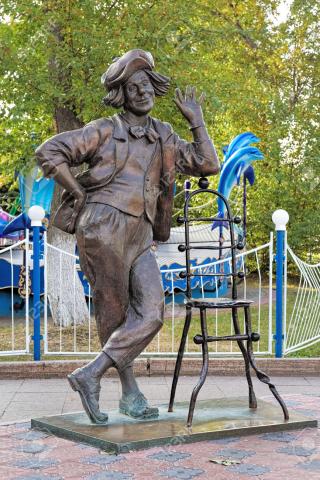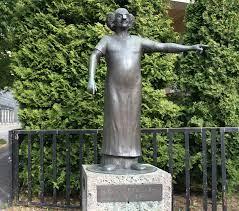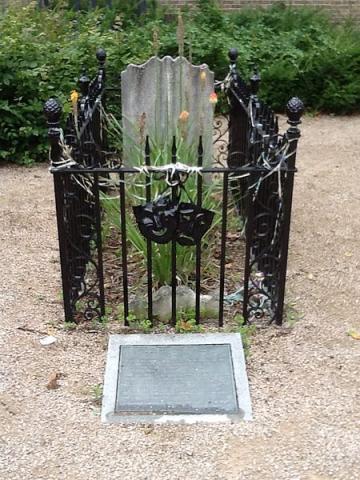
Acabo de tomar una cerveza en un bar y la camarera, tras hacerle yo una broma al pagar, me ha regalado, sin ella saberlo, el mejor de los cumplidos: “Tú eres un poco payaso”, me ha dicho cariñosamente. Digo cariñosamente porque son muchos los que, ignorantes de lo que significa payaso, lo utilizan peyorativamente, como un arma arrojadiza.
“España es el único país del mundo en el que la palabra payaso se usa despectivamente. Ya estoy acostumbrado a que se llame payaso a todo el mundo que hace una tontería”, me contaba hace unos años el payaso español Kim León, hijo del también payaso Pepín León. “Hace poco iba en un taxi y un coche nos adelantó peligrosamente. Y me dice el taxista: ‘¡Será gilipo**** el tío...! ¡Será payaso…! ¿Ha visto usted lo payaso que es el tío ese?’. Y le respondo yo: ‘¿Usted me ve hacer burradas semejantes? Porque yo soy payaso profesional y no hago ninguna cosa de esas”.
Recuerdo que, siendo adolescente, un día el profesor nos preguntó en la escuela que profesión nos parecía la más necesaria para la sociedad. Médico, ingeniero, arquitecto, abogado... Casi todos dijimos alguna de estas, pero un compañero respondió: “Payaso”. El profesor aplaudió su respuesta y yo me quedé pensando: “Payaso, claro. Pues no necesita poco el mundo que lo hagan reír, que le den poco de alegría...”.
El payaso no es, efectivamente, ese tipo de persona que se descalifica a sí mismo con sus actos y a la que se refieren los que utilizan despectivamente una palabra tan hermosa. No, el payaso no es ese tipo de persona, sino todo el contrario: “El payaso no es un personaje, sino una persona; el más humano de los seres humanos”, dice Alex Navarro, maestro de payasos y creador de clownplanet.com, la mejor web en español sobre tan fascinante mundo.
El niño interior
El payaso es el más humano de los seres humanos porque, como quiere la escritora española Ana María Matute (“el niño no es un proyecto de hombre, sino que el hombre es lo que queda del niño que fue”), no ha matado al niño que lleva dentro. El payaso, como Jesús, deja que los niños se acerquen a él. El payaso, como Jesús, se ha hecho como un niño. “Un payaso es un niño torpe de cero a doce años”, me decía en otra ocasión el argentino Adolfo Maguna, que lleva más de cuarenta años siendo en España el payaso Popín. Y el holandés Eric De Bont, uno de los principales maestros de clown de Europa, director de una escuela internacional de payasos en las Islas Baleares, explica siempre a sus alumnos que “los niños de cuatro o cinco años y las personas con síndrome de Down son clowns naturales”. El payaso, como el niño, descubre cosas cada segundo y busca compartirlas con los demás, hacerlos cómplices. El payaso, como afirma Jesús Jara, otro maestro de payasos, en su libro El clown. Un navegante de las emociones, “es como el niño que necesita que sus padres participen constantemente de su aprendizaje y de su constante evolución. “Mira, papá, mira lo que hago... Mira, mamá, mira lo que siento... Mirad. Mirad y miradme: este soy yo, esto me emociona, esto he descubierto... Quiero ir allá... ¿Puedo ir allá?”.
Por eso, cualquier maestro de clown que se precie no cesa de repetir que cada uno lleva dentro un niño, un payaso, y que se trata solo de dejar salir a ese niño, a ese clown único e intransferible. “Sé un payaso, sé tú mismo” es la consigna. El payaso existe ya dentro de uno mismo, es uno mismo. Como dice el actor y director de cine italiano Roberto Benigni, “el actor inventa o interpreta un personaje, mientras que el payaso es él mismo”. “El payaso está dentro de cada uno de nosotros. Es cuestión de dejarlo salir, de echar abajo los muros que edificamos para protegernos, de quitarnos las caretas que nos hemos ido poniendo con los años”, explica Navarro en su web. “Ser payaso es dejar salir al niño que llevamos dentro, abrir la puerta a la locura interna, conectarnos con una dimensión que siempre estuvo ahí. Un payaso auténtico es aquel que no actúa, sino que es, que no se esconde detrás de la careta del maquillaje o de la nariz”.
El payaso es el más humano de los seres humanos no solo porque posee en él lo mejor de los hombres, sino también porque es capaz de sacar de los demás lo mejor de ellos, de provocar que lo saquen, como expresa muy bien la siguiente anécdota del español Charly Rivel, uno de los mejores payasos del mundo de su época, contada por Navarro: “Cuando entró en la pista para empezar su actuación, un niño, que probablemente veía a un payaso por primera vez, comenzó a llorar desesperadamente. Como el público estaba más pendiente del niño que del payaso, Charly se acercó a él para hacerle una carantoña e intentar calmarlo, pero el efecto fue el contrario. Charly, que conocía profundamente la psicología infantil, se retiró al centro de la pista y comenzó también a llorar desconsoladamente, solidariamente. El niño calló de pronto, con los ojos abiertos como platos por la sorpresa de descubrir que aquel ser rojo y amenazador sabía expresarse también con el mismo lenguaje tan transparente y directo: el llanto. Sin dejar de llorar, Rivel se acercó otra vez al niño, que, ya calmado y mirándolo electrizado, se quitó el chupete de la boca y se lo dio a Charly en un acto de solidaridad primitiva”.
La fiesta de los fracasos
El payaso, como el niño, está siempre alerta y disponible para participar, para imitarlo todo, para intentar hacerlo todo por sí mismo. “¡Yo solo! ¡Yo solo!”, dice el niño cuando su madre le quiere ayudar a realizar cualquier cosa. “¡Yo solo! ¡Yo solo!”, dice también el payaso. Pero el payaso, como el niño, no sabe, se confunde, se cae, fracasa. “Bienvenidos a la fiesta de los fracasos”, les dice siempre De Bont a sus alumnos de clown. El payaso muestra la poesía que hay en el fracaso humano, en los defectos. Pone un espejo relativizador delante de nuestros ojos. “¿Has oído decir que ganar está bien? Pues yo te digo que perder también está bien. Las batallas se pierden con la misma dignidad con la que se ganan”, escribió Mark Twain.
En cierta ocasión, tomando algo con unos amigos, en el transcurso de la conversación salió a colación la figura del payaso –no recuerdo por qué–, y yo pregunté: “Al fin y al cabo, ¿qué es ser un payaso?”. Mi ahijado, que tenía doce años, contestó: “Ser payaso es humillarse a sí mismo”. La respuesta nos desconcertó a todos e incluso su madre dijo: “¿Humillarse? Eso nunca; eso es horrible”. Yo, después de pensarlo un momento, apunté: “Pues sí, creo que es una buena respuesta”. Pero, para cerciorarme, acudí al diccionario y les leí las siguientes definiciones: “Humillarse: hacer actos de humildad”. “Humildad: virtud que consiste en el conocimiento de las propias limitaciones y debilidades y en obrar de acuerdo con este conocimiento”. Efectivamente, eso es lo que hace el payaso: saberse limitado y débil, y obrar en consecuencia. Pero en ese obrar en consecuencia está el volver a intentar hacer todo por sí mismo, no desde la soberbia de quien se cree sobradamente capaz, sino desde la humildad de quien tiene que repetir su intento porque ha fracasado previamente.
Este fracaso repetido, desde la humildad y la ingenuidad, es lo que nos hace reír o al menos sonreír, porque, más allá de que sus torpezas resulten cómicas, todos nos sentimos identificados con él de alguna manera, y sus limitaciones y debilidades, unidas a su gran corazón, nos tocan el alma, porque son las nuestras. En definitiva, lo que hace el payaso es reírse de sí mismo, exactamente lo mismo que el humorista, porque el payaso, en contra de lo que muchos creen, es un humorista y no un cómico, ni mucho menos un satírico, que lo que hace es reírse de los demás (humillar, no humillarse).
El payaso, como dice De Bont, es “un barril de desesperación”: desesperación por sus repetidos fracasos, porque no acierta a hacer bien aquello que se propone, y desesperación también por su búsqueda desesperada de la complicidad de los demás. El payaso, como el niño, hace de la complicidad de los demás una auténtica necesidad (“Mira, papá, mira lo que hago... Mira, mamá, mira lo que siento”). El fracaso no amedrenta el payaso; no lo condena a la inactividad ni mucho menos a esconderse, a levantar un muro tras el que protegerse, a meterse dentro de una coraza. No lo retrae o aísla, no lo convierte en antisocial o individualista. El payaso, como el niño que se cayó, vuelve a la carga con más ímpetu, siempre a pecho descubierto, desnudo, transparente.
El payaso es transparente hasta cuando intenta esconder. Transparente y vulnerable. Su transparencia, su desnudez lo hacen vulnerable. Una transparencia, una desnudez de las que dan fe sus ojos, su mirada. “Sus sentimientos escapan por sus ojos como el humo por la chimenea, de manera natural, irrefrenable, casi involuntaria”, dice Jara. “Si un clown no nos mira, no existe”, advierte. Una mirada que, según el autor, “es una puerta abierta para comunicar; un diario abierto a través del cual recibimos permanentemente información sobre sus intenciones, ilusiones, experiencias, decepciones, miedos, deseos; un guiño de complicidad, una invitación a la confidencia”. “Y ante esa desnudez, ante tanta dignidad para mostrarse, al público solo le queda una respuesta, una actitud: el respeto y la admiración”, sentencia Jara. Es a este monumento a la dignidad al que despreciamos cada vez que intentamos descalificar a alguien llamándole payaso.

Oleg Popov, payaso ruso

Charlie Rivel, payaso español

Sepulcro Joseph Grimaldi, payaso inglés
Praise of the clown
By Félix Caballero
I just had a beer in a bar and the waitress, after I made a joke when paying, gave me, without her knowing it, the best of compliments: “You're a bit of a clown,” she told me affectionately. I say affectionately because there are many who, ignorant of what clown means, use it pejoratively, as a throwing weapon.
“Spain is the only country in the world in which the word clown is used derogatorily. "I'm already used to everyone who does something stupid being called a clown," Spanish clown Kim León, son of fellow clown Pepín León, told me a few years ago. “Recently I was in a taxi and a car overtook us dangerously. And the taxi driver tells me: 'The guy will be an idiot...! He will be a clown…! Have you seen what a clown that guy is?' And I respond: 'Do you see me doing similar stupid things? Because I am a professional clown and I don't do any of those things."
I remember that, as a teenager, one day the teacher asked us at school which profession we thought was the most necessary for society. Doctor, engineer, architect, lawyer... Almost all of us said one of these, but a classmate responded: “Clown.” The teacher applauded his response and I was left thinking: “Clown, of course. Well, the world needs little to be made to laugh, to give it a little joy..."
The clown is not, in fact, that type of person who disqualifies himself with his actions and to whom those who derogatorily use such a beautiful word refer. No, the clown is not that type of person, but quite the opposite: “The clown is not a character, but a person; the most human of human beings,” says Alex Navarro, clown teacher and creator of clownplanet.com, the best website in Spanish about such a fascinating world.
The inner child
The clown is the most human of human beings because, as the Spanish writer Ana María Matute wants (“the child is not a man's project, but the man is what remains of the child that was”), he has not killed the clown. child within. The clown, like Jesus, lets the children come to him. The clown, like Jesus, has become like a child. “A clown is a clumsy child from zero to twelve years old,” the Argentine Adolfo Maguna told me on another occasion, who has been the clown Popín in Spain for more than forty years. And the Dutchman Eric De Bont, one of the main clown teachers in Europe, director of an international clown school in the Balearic Islands, always explains to his students that “four or five year old children and people with Down syndrome “They are natural clowns.” The clown, like the child, discovers things every second and seeks to share them with others, make them accomplices. The clown, as Jesús Jara, another clown teacher, states in his book El clown. A navigator of emotions, “is like the child who needs his parents to constantly participate in his learning and constant evolution. “Look, dad, look at what I do... Look, mom, look at what I feel... Look. Look and look at me: this is me, this excites me, this I have discovered... I want to go there... Can I go there?
For this reason, any self-respecting clown master never stops repeating that everyone has a child inside, a clown, and that it is just a matter of letting that child out, that unique and non-transferable clown. “Be a clown, be yourself” is the slogan. The clown already exists within oneself, it is oneself. As the Italian actor and film director Roberto Benigni says, “the actor invents or interprets a character, while the clown is himself.” “The clown is inside each of us. It is a matter of letting it out, of tearing down the walls that we build to protect ourselves, of taking off the masks that we have been putting on over the years,” explains Navarro on his website. “Being a clown is letting out the child inside us, opening the door to internal madness, connecting with a dimension that was always there. An authentic clown is one who does not act, but who is, who does not hide behind the mask of makeup or the nose.
The clown is the most human of human beings not only because he possesses the best of men, but also because he is capable of bringing out the best in others, of causing them to bring it out, as the following anecdote expresses very well. of the Spanish Charly Rivel, one of the best clowns in the world of his time, told by Navarro: “When he entered the dance floor to begin his performance, a child, who was probably seeing a clown for the first time, began to cry desperately. As the audience was more aware of the boy than the clown, Charly approached him to make a joke and try to calm him down, but the effect was the opposite. Charly, who knew child psychology deeply, retired to the center of the court and also began to cry uncontrollably, in solidarity. The child suddenly fell silent, his eyes wide open in surprise at discovering that this red and threatening being also knew how to express himself with the same transparent and direct language: crying. Without stopping crying, Rivel approached the child again, who, now calm and looking electrified, took the pacifier out of his mouth and gave it to Charly in an act of primitive solidarity.
The party of failures
The clown, like the child, is always alert and available to participate, to imitate everything, to try to do everything by himself. "Only me! "I alone!" says the child when his mother wants to help him do anything. "Only me! "I alone!", the clown also says. But the clown, like the child, does not know, he gets confused, he falls, he fails. “Welcome to the party of failures,” De Bont always tells his clown students. The clown shows the poetry that exists in human failure, in defects. It puts a relativizing mirror before our eyes. “Have you heard that winning is good? Well I tell you that losing is also good. Battles are lost with the same dignity with which they are won,” wrote Mark Twain.
On one occasion, having a drink with some friends, during the conversation the figure of the clown came up – I don't remember why – and I asked: “After all, what does it mean to be a clown?” My godson, who was twelve years old, answered: “To be a clown is to humiliate oneself.” The answer baffled us all and even his mother said: “Humble yourself? That never; that's horrible". I, after thinking about it for a moment, said: “Well yes, I think that is a good answer.” But, to make sure, I went to the dictionary and read the following definitions: “Humble yourself: do acts of humility.” “Humility: virtue that consists of knowing one's own limitations and weaknesses and acting in accordance with this knowledge.” Indeed, that is what the clown does: he knows he is limited and weak, and acts accordingly. But in this act accordingly is trying again to do everything by oneself, not from the arrogance of someone who believes themselves to be more than capable, but from the humility of someone who has to repeat their attempt because they have previously failed.
This repeated failure, from humility and naivety, is what makes us laugh or at least smile, because, beyond the fact that his clumsiness is comical, we all feel identified with him in some way, and his limitations and weaknesses, united to his great heart, they touch our souls, because they are ours. In short, what the clown does is laugh at himself, exactly the same as the comedian, because the clown, contrary to what many believe, is a humorist and not a comedian, much less a satirist, which is what What he does is laugh at others (humiliate, not humiliate himself).
The clown, as De Bont says, is “a barrel of despair”: despair due to his repeated failures, because he fails to do well what he sets out to do, and despair also due to his desperate search for the complicity of others. The clown, like the child, makes the complicity of others a genuine necessity (“Look, dad, look at what I do... Look, mom, look at what I feel”). Failure does not intimidate the clown; It does not condemn him to inactivity, much less to hide, to build a wall behind which to protect himself, to get inside a shell. It does not withdraw or isolate him, it does not make him antisocial or individualistic. The clown, like the child who fell, returns to the fray with more impetus, always with his chest exposed, naked, transparent.
The clown is transparent even when he tries to hide. Transparent and vulnerable. His transparency, his nakedness make him vulnerable. A transparency, a nudity that is attested to by his eyes, his gaze. “His feelings escape through his eyes like smoke through the chimney, naturally, uncontrollably, almost involuntarily,” says Jara. “If a clown doesn't look at us, it doesn't exist,” he warns. A look that, according to the author, “is an open door to communicate; an open diary through which we permanently receive information about your intentions, hopes, experiences, disappointments, fears, desires; a wink of complicity, an invitation to confidence.” “And in the face of that nudity, in the face of so much dignity to be shown, the public only has one response, one attitude: respect and admiration,” says Jara. It is this monument to dignity that we despise every time we try to disqualify someone by calling them a clown.
(This text has been translated into English by Google Translate)
